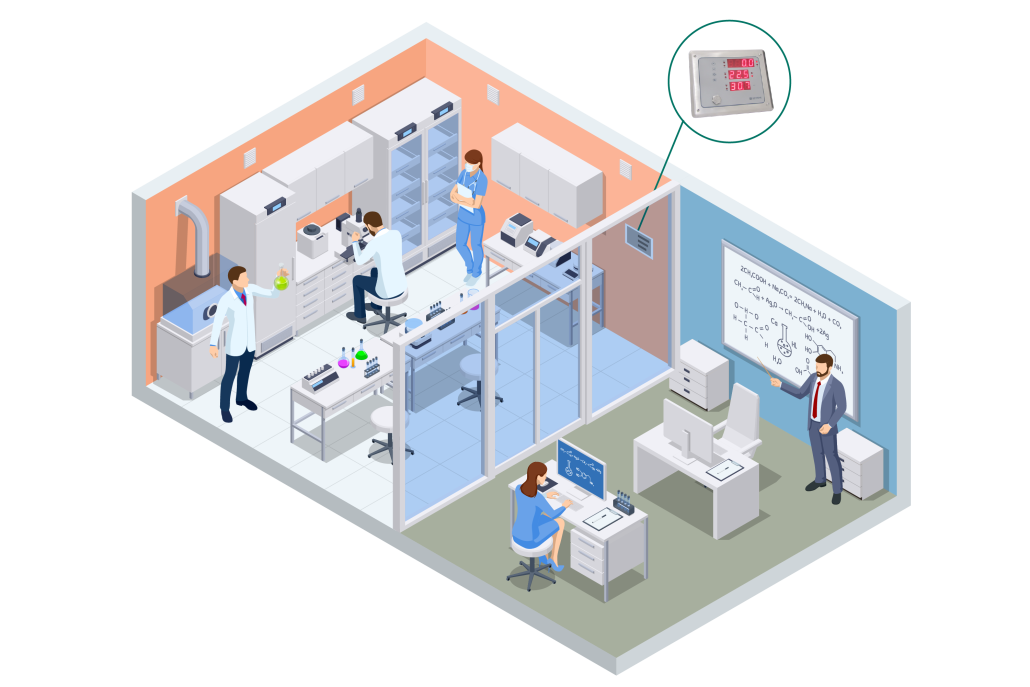A cleanroom is an engineered space, which maintains a very low concentration of airborne particulates. It is well isolated, well-controlled from contamination, and actively cleansed. Cleanrooms are an important part of any laboratory — compared to the ambient outdoor air in urban areas, which contain 35 million particles per cubic meter, cleanroom environments offer just 12 particles per cubic meter. This allows lab technicians to control the environment chemicals are used in. So let’s take a look at a few reasons why temperature, humidity and pressure monitoring in labs is important.
Temperature monitoring is important in laboratory because physical properties of substances can change as temperature varies. So, if the temperature in a lab environment isn’t stable, the substances being used in the lab may physically change. This, in turn, could make any results found from the testing unusable. Physical properties like viscosity, density, and even the form a substance takes can all be impacted by the temperature in the lab environment, which makes temperature monitoring essential.
Humidity is also an important factor that needs to be monitored. The concern is preventing contamination. Improper climate control can allow for the growth of microbes and bacteria. Not only does the temperature and humidity affect the lab, but it affects instruments. With high humidity, metals like gauge blocks will rust quickly. In an electrical area, when metals rust or corrosion occurs, this will create a leakage path for voltage and current which causes a malfunction or inaccurate reading. If below 20%, where the air is very dry, instruments can be prone to static electricity which will damage the electronic equipment. The temperature and humidity in a lab can also affect the speed of the chemical reaction.
The purpose of monitoring pressure in laboratories is to manipulate them into positive or negative pressure rooms. Positive pressure rooms maintain a higher pressure inside the treated area than that of the surrounding environment. This means air can leave the room without circulating back in. Positive pressure is used in cleanrooms where the priority is keeping any possible germs or contaminants out of the cleanroom. In the event that there was a leak, or a door opened, clean air would be forced out of the cleanroom, rather than unfiltered air being allowed into the cleanroom. Positive pressure cleanrooms are used primarily for industries where the cleanroom functions to keep the product clean and safe from particulates, like in the microelectronic industry where even the tiniest particle can damage the integrity of the microchips being manufactured. On the other hand, negative air pressure cleanrooms are used in industries that manufacture pharmaceutical products, do biochemical testing, and also in hospitals to quarantine seriously contagious patients. Any air that flows out of the room has to first flow out of a filter, ensuring that no contaminants can escape.
Maintaining optimal laboratory temperature and humidity is anything but a set-and-forget operation. You should be actively watching your lab to determine how well your current system works. Getting the right insights can help you determine how to improve these controls. The CR3 Series Cleanroom Monitor, was developed specifically to allow for monitoring of confined spaces with accuracy and reliability. The CR3 allows for either in-room or remote monitoring with three different models; integrated sensors, remote sensors or display only to suit a variety of installation needs. It features a flush fitting stainless-steel front plate that enables the user to wipe-down the unit when necessary. Check out our CR3 Cleanroom Monitor or talk to one of our team experts about getting the right solution for you.









